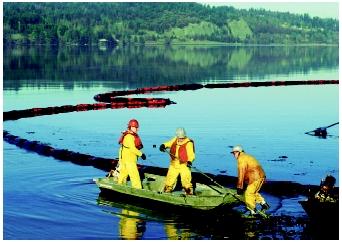Cleanup and Recovery
The techniques used to clean up an oil spill depend on oil characteristics and the type of environment involved; for example, open ocean, coastal, or wetland . Pollution-control measures include containment and removal of the oil (either by skimming, filtering, or in situ combustion), dispersing it into smaller droplets to limit immediate surficial and wildlife damage, biodegradation (either natural or assisted), and normal weathering processes. Individuals of large-sized wildlife species are sometimes rescued and cleaned, but micro-sized species are usually ignored.Oil spill countermeasures to clean up and remove the oil are selected and applied on the basis of many interrelated factors, including ecological protection, socioeconomic effects, and health risk. It is important to have contingency plans in place in order to deploy pollution control personnel and equipment efficiently.
Environmental Recovery Rates.
The rate of recovery of the environment when an oil spill occurs depends on factors such as oil composition and
Workers clean up an oil refinery spill that polluted Anacortes Bay, Washington. The floating ring of absorbent pads trailing behind the boat is being used to contain some of the oil that has spilled.
Because of the type of oil spilled and the Arctic environment in which it spilled, it is estimated that the residue of the Exxon Valdez oil spill will be visible on the Alaskan coast for 30 years.
Costs and Prevention
The costs of an oil spill are both quantitative and qualitative. Quantitative costs include loss of the oil, repair of physical facilities, payment for cleaning up the spill and remediating the environment, penalties assessed by regulatory agencies, and money paid in insurance and legal claims. Qualitative costs of an oil spill include the loss of pristine habitat and communities, as well as unknown wildlife and human health effects from exposure to water and soil pollution.Prevention of oil spills has become a major priority; and of equal importance, efforts to contain and remove oil that has spilled are considered to be prevention of secondary spills. The costs associated with oil spills and regulations governing offshore facilities and operations have encouraged the development of improved technology for spill prevention. The Oil Pollution Act of 1990 was enacted by the U.S. Congress to strengthen oil spill prevention, planning, response, and restoration efforts. Under its provisions, the Oil Spill Liability Trust Fund provides cleanup funds for oil pollution incidents.
Responsibility for the prevention of oil spills falls upon individuals as well as on governments and industries. Because the sources of oil waste in the ocean are generally careless, rather than accidental, truly effective prevention of oil spills involves everyone.
SEE ALSO B EACHES ; C OASTAL W ATERS M ANAGEMENT ; C ORALS AND C ORAL R EEFS ; E NERGY FROM THE O CEAN ; F ISHERIES , M ARINE ; M ARINE M AMMALS ; O CEAN H EALTH , A SSESSING ; P ETROLEUM FROM THE O CEAN .
Carolyn Embach
Bibliography
American Petroleum Institute. Fate of Spilled Oil in Marine Waters. Publication Number 4691. Washington, D.C.: American Petroleum Institute, 1999.Carls, Mark G. et al. "Persistence of Oiling in Mussel Beds after the Exxon Valdez Oil Spill." Marine Environmental Research 51, no. 2 (2001):167–190.
Raloff, Janet. "Valdez Spill Leaves Lasting Impacts." Science News no. 143 (February 13, 1993):102.
U.S. Environmental Protection Agency. Understanding Oil Spills and Oil Spill Response. Publication Number 9200.5–105. Washington, D.C.: U.S. Environmental Protection Agency, 1993.
RECOVERING FROM THE EXXON VALDEZ OIL SPILL
A large quantity of crude oil was deposited on beaches in Prince William Sound and along the shoreline of the Gulf of Alaska after the Exxon Valdez tanker wrecked in 1989. The oil waste has been closely monitored to determine its status and its effects in the ocean and along the coast.Initial efforts to remove the oil from intertidal areas included flushing them with hot water applied with high pressure, which proved fatal for much of the marine life involved. Natural rates of biodegradation and recovery have been slower than anticipated, and visible residue may persist for up to 30 years.
Ads by Google
Oil Water Separators - Patented OWS, 5ppm Separation Oil Extraction 99.7% Free Of Water - www.freytech.com
Spill International - Your online source on Marine Spills and Pollution. Stay up to date! - www.spill-international.com
Read more: Oil Spills: Impact on the Ocean - sea, effects, temperature, percentage, important, largest, types, source, marine, oxygen, human http://www.waterencyclopedia.com/Oc-Po/Oil-Spills-Impact-on-the-Ocean.html#ixzz1CS0kQe6d